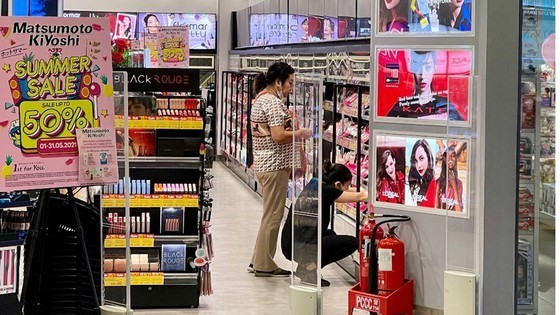A series of regional and international consumers’ brands in recent years have made waves on Vietnamese market, for instance the Japanese dollar-store franchise Daiso that sees a surplus of buyers even when only 30 to 40 percent of goods are of Japanese origins.
Besides Daiso, other franchises from Korea, Japan, or Hong Kong (China) such as Miniso, Hachi Hachi and Komonoya have been choosing favorable locations for retail outlets in HCMC and implement methodical business strategies with high-quality and diverse goods.
A quick survey by SGGP Newsaper showed that consumers’ goods of Vietnamese origin account for a relatively small percentage in dollar-store equivalencies in Vietnam.
The cosmetics and health care sector have also seen new brand names, mostly from Hong Kong (China) and Japan.
Cosmetics shelves at Vincom, Dong Khoi Street, HCMC. (Photo: SGGP)
Data from a number of market research groups show that the Vietnamese cosmetic market is worth some about US$2.3 billion as of the end of 2018, but mainly operates under the traditional retail model with a certain lack of modern retail chains.
Additionally, statistics show a 56 percent growth rate in the cosmetic and diet supplement sectors, showing great potential for growth, experts said. HCMC is also seeing the rise of the middle-income class and preference for foreign goods.
HCMC authorities since 2018 have approved the master plan to develop the city’s trade industry in the 2025-2030 period with the aim to properly orient the market. The plan involves turning HCMC into an essential hub of commerce, service and finance in Southeast Asia, and retail achieving a 50 percent ratio by 2025 and 60 percent by 2030.
The city’s commercial development plan is based on four key sectors: export, logistics, exhibitions and wholesale and retail.
The government has also implemented solutions for commercial infrastructure development, trade support services, capital sources, human resource training and management quality improvement. The city plans to establish the HCMC Retail Business Association within 2021 aimed to bridge the gap between authorities and private companies.





















